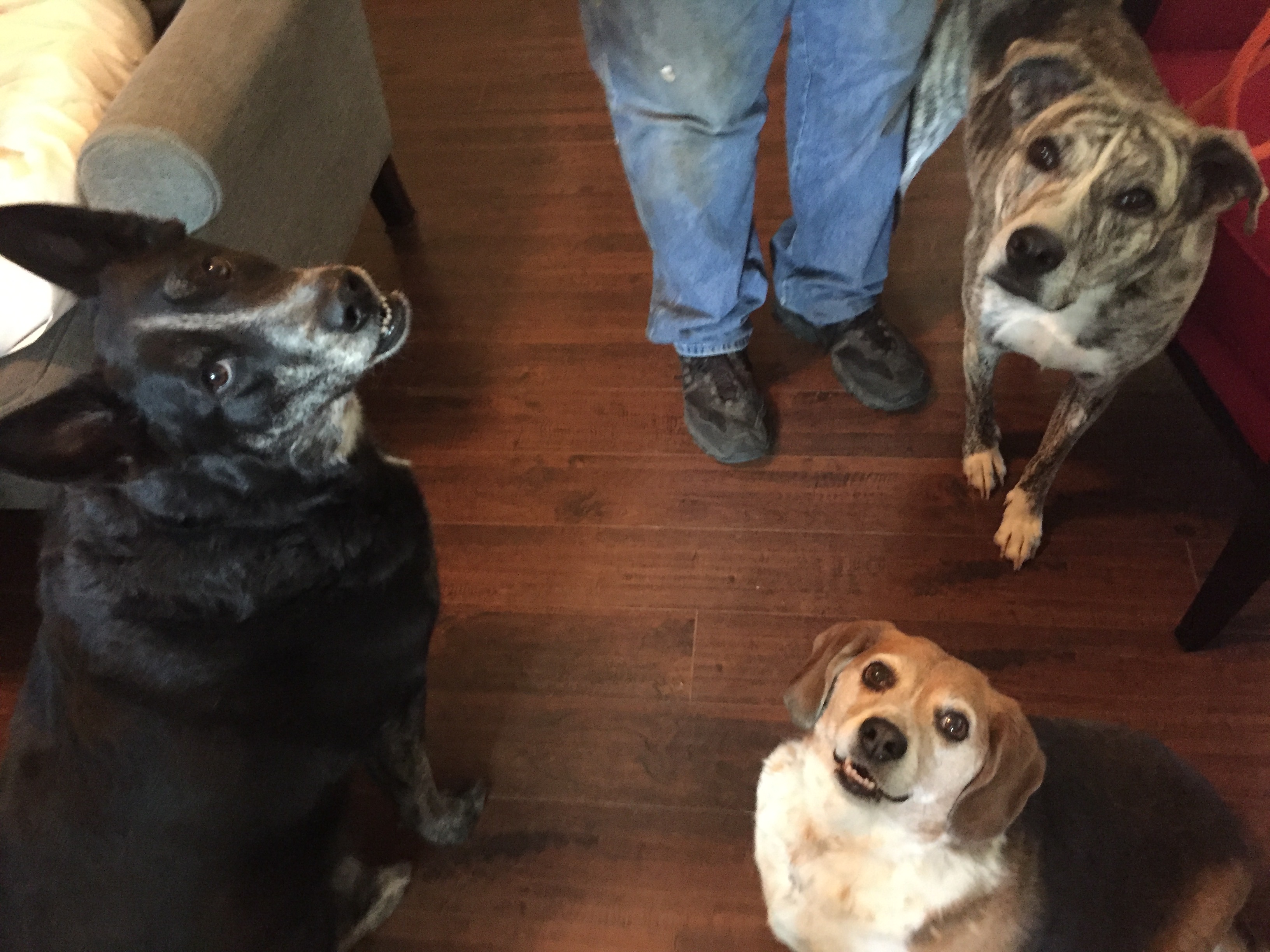How to Stop Aggressive Behavior Between Dogs Living in the Same Household
By: Sam Kanouse
Published Date: June 27, 2017
By: Sam Kanouse –
Shannon is a ten-year-old, female Beagle who lives with her sisters Blue a five-year-old Blue Heeler mix and Lady a three-year old Greyhound mix that live in Omaha. Their guardians set up a dog behavior training session with us because of some dog aggression issues, where Lady had attacked Shannon the Beagle several times and it had started making their other dog Blue anxious.
Lady and Shannon had been separated from each other for about three weeks to keep them safe. Lady stayed in her kennel during the door greeting while Shannon and Blue were free to roam around the house. Both girls were happy to greet me at the door, Blue did try to push through the door to greet me. After entering the house both dogs calmed down quickly.
When I sat down with the guardians to discuss the dogs’ behavioral issues, I learned that the dogs did not really have any rules in place. When dogs do not have rules it often leads to them deciding that they must be the leaders of the house, which can lead to behavioral issues. This can lead to aggressive behavior between dogs as the dogs attempt to assert themselves as the number one leader, since their guardians are not establishing themselves as the leader.
At first, it appeared to me that Shannon the Beagle was the dog initiating the aggressive behavior. However, upon further inspection I realized that it was Lady the Greyhound mix who was challenging Shannon for a leadership position. Lady was insecure and was attempting to cope with this by challenging Shannon. When Shannon communicated through growling that she wanted Lady to respect her space, Lady quickly escalated into attacking Shannon.
I talked to the dogs’ guardians about establishing themselves as the leaders in the house and the dogs as the followers. The exercises that we covered during our session are different from dog training and obedience training because we are targeting a change in leadership in the house, rather than teaching your dog to listen to commands. In order to achieve this leadership shift, I gave the guardians some rules to follow such as no furniture, sitting before going outside and structured feeding.
Since the Lady and Shannon had been separated for a couple of weeks after the last aggressive episode, we started with counterconditioning. First we moved the dogs far apart in the house, with leashes on to provide safety and control, where they could still see each other. We gave the dogs treats only when they were looking at each other. This way we could use positive reinforcement by giving a food reward when they looked at each other, making a positive association, and removing the reward when the other dog was absent.
Next, we took the dogs outside and started with the guardians walking the dogs next to each other. The dogs were positioned away from one another with the guardians in the middle to give maximum space and security. The dogs were walked together in parallel so neither was in front of the other. When one dog walks ahead of another it is one way that they can assert a leadership position.
See the video below to see how we got Lady and Shannon walking next to each other.
As you can see in the video both dogs were able to increase proximity as we took them on walks. The signs that we were look for are having their tails low and held in a relaxed position. Another behavior that you can see in the video is Lady licking her lips and yawning, in dog psychology these are all calming signals. This shows that the two dogs are making great progress to building a balanced relationship.
After we took the two dogs for a couple of walks, we were able to include Blue. I wanted Blue to see that Lady and Shannon were establishing a balanced relationship, because the aggressive behavior had made Blue anxious.
Food is one of the most important resources for dogs, so ensuring that the guardians controlled the food further helped them establish themselves in the leadership position. I asked the guardians at the beginning of the session which dog they thought listened the best and had the best behavior overall. They said Blue was the best dog and always listened to their commands.
Structured feeding is when the guardians eat first and then allow each dog to eat in a specific order. Since Blue is the best behaved she got to eat first. The guardians need to claim the feeding area as theirs and the dogs are only allowed near the food when they are given permission. In the dog world it is rude to eat in close proximity to each other. Once the guardians gave one dog permission to eat, they left the room and claimed the doorway so the other dogs wouldn’t invade the space. Each dog was given three-minutes to eat without having the other dogs in the room.
In order for the guardians to establish themselves as the leaders and continue to have good behavior from Shannon, Lady and Blue they will need to repeat structured feeding for each meal and the counterconditioning and walking exercise over and over again. These exercises combined with plenty of exercise, rules and structure should allow the dogs to adopt a follower’s mindset, which will help them have a balanced relationship with each other.
We wrapped up this session with their Road Map to Success video, which you can watch below.
Categorized in: Dog Behavior


